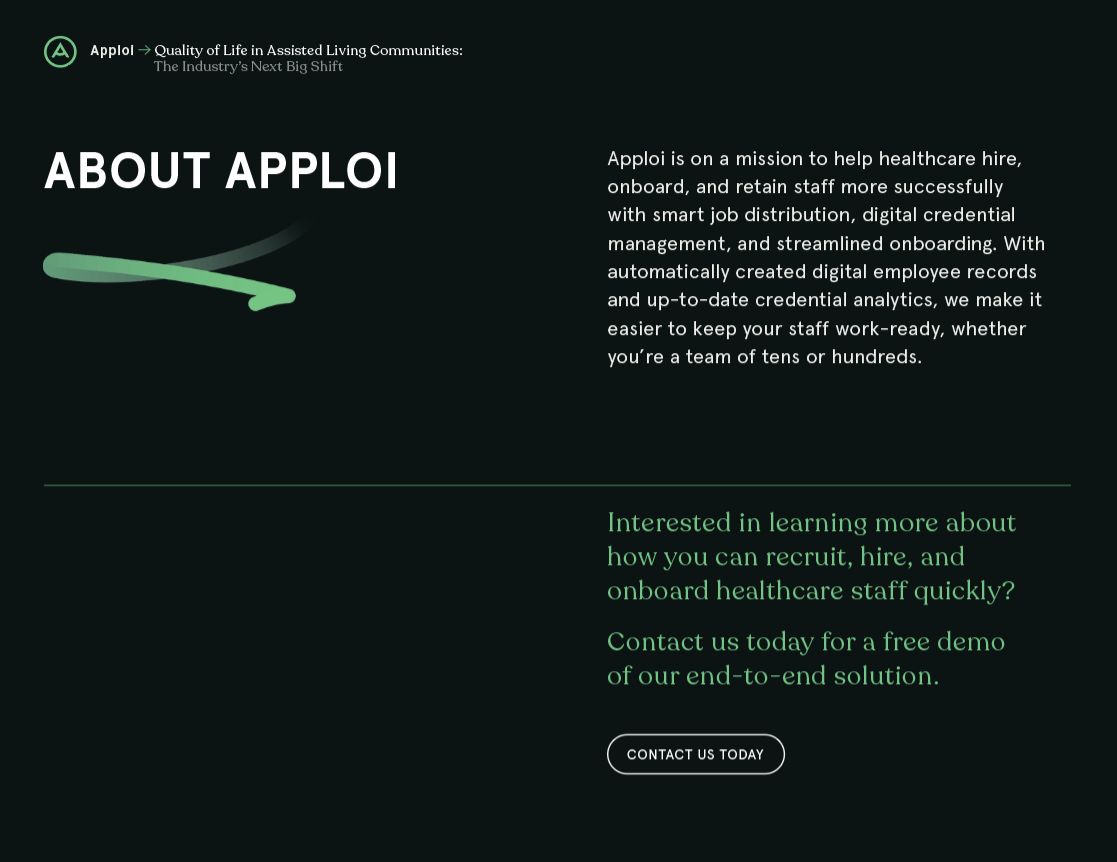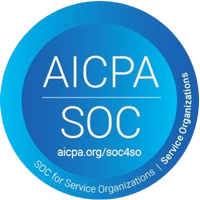RECRUITING FOR SENIOR LIVING COMMUNITIES
In senior living, your reputation is everything. It connects to all other aspects of your business—your ability to find new hires, hold onto the employees you’ve got, create a community where residents want to stay, and drive your business’s growth.
There are plenty of challenges facing senior living that are outside of anyone’s business’s control. Luckily, there are aspects of staffing that you can control. That starts with your reputation.
Here, we explain how to improve your facility’s recruiting and retention strategy for sustainable business growth.
Understanding the Demands on Senior Living
An Aging Population
Senior living is under great pressure. But where does this pressure come from?
The greatest factor is America’s changing demographics. By 2034, for the first time in history, America’s 65-and-older population is projected to outnumber children under 18.
An older population means two things for senior living: greater demand and fewer potential candidates. The fact that America is about to see its largest-ever population of older citizens is reason enough for senior living communities to expect greater demand. But add to that the fact that healthcare workers are also reaching retirement age (or leaving their positions early due to COVID-related stress and burnout), and you have the components for an ever-worsening candidate shortage.
Changing Desires
The population of older Americans is growing, but that’s not the only change. Compared to past senior generations, this cohort is more likely to hold onto their independence, and less willing to give up the aspects of their lives that make their days feel meaningful.
Today’s generation of older Americans wants greater independence, more cultural and leisure activities, and more control in their care plans. In addition, more seniors are middle-income than any other income bracket, and they may neither qualify for Medicare nor have the means to pay for traditional long-term care. Senior living businesses will need to adopt more flexible care options to widen the pool of potential residents.
How to Improve Culture in Senior Living
Staffing and company culture can’t be separated. A strong culture is one where workers feel respected, fulfilled, and confident in their ability to do their jobs well. If you’re understaffed, all of these elements are threatened.
Culture or Wages?
Even if you successfully attract new hires with competitive pay or sign-on bonuses, your culture will determine your retention rate.
Compensation is vital, especially for lower-wage workers who could easily leave the healthcare industry and find comparable pay elsewhere. Recruiting with sign-on bonuses can work. But it won’t work for long if you’re dealing with an unhealthy work culture.
Fair pay is part of a strong culture, but it can’t singlehandedly create the safe and supportive environment that workers seek.
How to Improve Company Culture in Senior Living
If pay alone doesn’t improve culture, what does? Culture is holistic. A strong company culture is supportive, safe, encouraging, and protects workers’ mental and physical health.
Protect Your Workers
Workers should feel confident that their physical, mental, and medical safety will be protected at work. Stick to your safe staffing ratios and a schedule that allows adequate time for workers to rest between shifts. If this is a challenge, focus first on streamlining your recruiting practices so you can hire more rapidly.
Workers’ protections should extend to the physical and emotional. Minimize the risk of workplace violence with de-escalation training and zero-tolerance policies. Additionally, protect workers’ mental health with enforced time off, counseling services, and by normalizing mental health care.
Support Career Growth
Career growth ties directly to retention rates. For every 10 months an employee stays in the same position, their likelihood of turnover increases by a percentage point. Schedule quarterly meetings with employees to check in on their career goals and plan their growth.
Provide Flexible Benefits
Allow employees to opt into services like childcare and transit reimbursement so they can proactively choose the benefits that would actually help them.
Build Relationships With Your Surrounding Community
Your relationships, both within and outside of your community, have an impact on workers’ self-image, fulfillment, and stress levels. Host regular events that are open to the community. Reach out to staff at skilled nursing facilities and social workers. These may very well be the people who are directing residents to your community.
Effective Job Posts for Senior Living Communities
Create Compelling Job Descriptions
Accurate Job Descriptions
Your first priority when writing a job post is to make sure it’s accurate. Be careful when recycling job descriptions—“close enough” is rarely truly close enough. Inaccurate job descriptions can attract the wrong candidates, slow down hiring, and irritate candidates. If an employee is let go for failing to meet responsibilities that are not accurately represented in the job description, it’s even possible they could sue for wrongful termination.
SEO Quick Tips
With search engine optimization, you can make sure your job posts are seen by more candidates. Here’s how:
- Create a separate web page for every one of your open positions to make it easier for candidates to find your jobs through a search engine
- Include the most important information, such as job title and location, in the title of the job description
- Include keywords related to duties, requirements, specializations, and work culture in the body of your job description (“entry-level,” “flexible,” “full time,” “associates degree,” “remote,” et cetera)
- Use job titles that are common to your industry, even if internally you call the roles by different names
- Try to include multiple descriptions of the same role so candidates will see your post no matter their search term (“CNA,” “nursing assistant,” “healthcare assistant,” et cetera)
- Include relevant links to your other webpages to give candidates a sense of your work culture and business goals


FREE EBOOK
Get your step-by-step guide to hiring and retention
Unbiased Language
After you’ve drafted your job description, read it through one more time searching for biased language that could negatively affect your hiring. Use gender-neutral language (including the singular “they”) when talking about candidates and hires. Overall, candidates prefer generic language.
Consider your requirements carefully, and try to only require what’s truly important. The popularity of college majors varies by gender and ethnicity, and degree of experience will depend on a myriad of factors. Make your job post as open as you reasonably can.
It’s not perfect, but a tool like the Gender Decoder can help you guess if candidates assume you favor one gender over another.
Visual Interest
Make your job posts easy to read, even if a candidate only looks at them for a matter of seconds. Include plenty of white space, and break up sections with images from your business.
Include your own unique assets, like logos and company colors. Keep your templates consistent, both for the sake of professionalism and to make them easier to control and create.
How to Recruit Senior Living Staff, Step-by-Step
In Person Recruiting
Host Hiring Events
Along with appearing at existing job fairs and connecting directly with local medical programs, employers can host their own community hiring events. Schedule time for open interviews and facility tours to make it as quick and easy as possible for candidates to apply.
In-House Training
Some roles, like certified nursing assistants, can be trained in-house. Offering in-house training attracts candidates who are new to healthcare roles, and allows employers to train workers on the exact practices and policies that are relevant to their business. Free training programs can greatly improve a business’s reputation in their surrounding community.
Digital Recruiting
Pick Your Job Boards
Since many job sites charge a fee, you’ll probably need to be selective about where you post your opportunities. If you’re not using a service like Apploi, which distributes to dozens of job sites for a bundled fee, your best bet is to start with the most popular job boards. Most healthcare candidates come from widely used job sites like ZipRecruiter, Indeed, and Google Jobs. Prioritize these. You can branch into healthcare-specific job boards as necessary.
Post to Social
Once your job is live, share it to your social media channels. Distribute jobs on whatever social channels you maintain. Twitter, LinkedIn, Facebook, and TikTok are all good options. One study suggests that almost 92% of healthcare professionals use social media while at work, making it an extremely promising channel to connect with qualified candidates.
Promote With Job Ads
Sponsored job ads are one more way to connect with passive candidates. Job ads can be digital (including Facebook and Indeed campaigns), but they can also be more catered to your local media. Employers can advertise jobs on local radio, with billboards, and even with vinyl car wraps.
Encourage Sharing
On social media, you can encourage your followers to share your job openings, which is one of the easiest (and cheapest) ways to expand your reach. Ask your followers and current employees to share openings, and make it easy for visitors to subscribe to your job notifications.


FREE EBOOK
Get your step-by-step guide to hiring and retention
